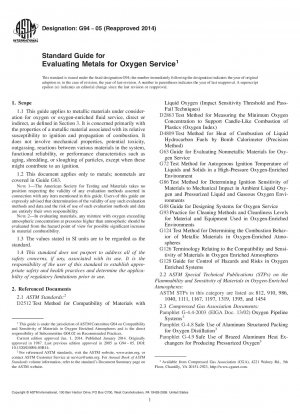ASTM G94-05(2014)
Standard Guide for Evaluating Metals for Oxygen Service
- Standard No.
- ASTM G94-05(2014)
- Release Date
- 2005
- Published By
- American Society for Testing and Materials (ASTM)
- Status
- Replace By
- ASTM G94-22
- Latest
- ASTM G94-22
- Scope
4.1 The purpose of this guide is to furnish qualified technical personnel with pertinent information for use in selecting metals for oxygen service in order to minimize the probability of ignition and the risk of explosion or fire. It is intended for use in selecting materials for applications in connection with the production, storage, transportation, distribution, or use of oxygen. It is not intended as a specification for approving materials for oxygen service.
1.1 This guide applies to metallic materials under consideration for oxygen or oxygen-enriched fluid service, direct or indirect, as defined in Section 3. It is concerned primarily with the properties of a metallic material associated with its relative susceptibility to ignition and propagation of combustion. It does not involve mechanical properties, potential toxicity, outgassing, reactions between various materials in the system, functional reliability, or performance characteristics such as aging, shredding, or sloughing of particles, except when these might contribute to an ignition.
1.2 This document applies only to metals; nonmetals are covered in Guide G63.
Note 1—The American Society for Testing and Materials takes no position respecting the validity of any evaluation methods asserted in connection with any item mentioned in this guide. Users of this guide are expressly advised that determination of the validity of any such evaluation methods and data and the risk of use of such evaluation methods and data are entirely their own responsibility.Note 2—In evaluating materials, any mixture with oxygen exceeding atmospheric concentration at pressures higher than atmospheric should be evaluated from the hazard point of view for possible significant increase in material combustibility.1.3 The values stated in SI units are to be regarded as the standard.
1.4 This standard does not purport to address all of the safety concerns, if any, associated with its use. It is the responsibility of the user of this standard to establish appropriate safety and health practices and determine the applicability of regulatory limitations prior to use.
ASTM G94-05(2014) Referenced Document
- ASTM D2512 Standard Test Method for Compatibility of Materials with Liquid Oxygen (Impact Sensitivity Threshold and Pass-Fail Techniques)
- ASTM D2863 Standard Test Method for Measuring the Minimum Oxygen Concentration to Support Candle-like Combustion of Plastics (Oxygen Index)
- ASTM D4809 Standard Test Method for Heat of Combustion of Liquid Hydrocarbon Fuels by Bomb Calorimeter (Precision Method)
- ASTM G124 Standard Test Method for Determining the Combustion Behavior of Metallic Materials in Oxygen-Enriched Atmospheres
- ASTM G126 Standard Terminology Relating to the Compatibility and Sensitivity of Materials in Oxygen Enriched Atmospheres
- ASTM G128 Standard Guide for Control of Hazards and Risks in Oxygen Enriched Systems
- ASTM G63 Standard Guide for Evaluating Nonmetallic Materials for Oxygen Service
- ASTM G72 Standard Test Method for Autogenous Ignition Temperature of Liquids and Solids in a High-Pressure Oxygen-Enriched Environment
- ASTM G86 Standard Test Method for Determining Ignition Sensitivity of Materials to Mechanical Impact in Ambient Liquid Oxygen and Pressurized Liquid and Gaseous Oxygen Environments
- ASTM G88 Standard Guide for Designing Systems for Oxygen Service
- ASTM G93 Standard Practice for Cleaning Methods and Cleanliness Levels for Material and Equipment Used in Oxygen-Enriched Environments
ASTM G94-05(2014) history
- 2022 ASTM G94-22 Standard Guide for Evaluating Metals for Oxygen Service
- 2005 ASTM G94-05(2014) Standard Guide for Evaluating Metals for Oxygen Service
- 2005 ASTM G94-05 Standard Guide for Evaluating Metals for Oxygen Service
- 1992 ASTM G94-92(1998) Standard Guide for Evaluating Metals for Oxygen Service
